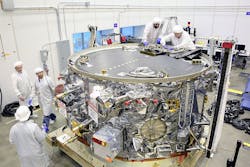Orbital ATK satellite facility delivers Cygnus service module to NASA for ISS cargo delivery
DULLES, Va., 13 Oct. 2015. Orbital ATK Inc. (NYSE:OA) has shipped the Cygnus spacecraft’s service module to NASA’s Kennedy Space Center for the next International Space Station (ISS) cargo mission, scheduled to launch on 3 December 2015, under the Commercial Resupply Services (CRS) contract.
The Cygnus spacecraft will be assembled at Kennedy and launched aboard a United Launch Alliance (ULA) Atlas V rocket. The mission marks the first flight of the enhanced variant of the Cygnus spacecraft, capable of delivering more than 7,700 pounds of essential crew supplies, equipment, and scientific experiments to astronauts on board the ISS.
The service module, which houses the spacecraft’s avionics, electrical, propulsion, and communications systems, will integrate with an extended pressurized cargo module (PCM) already in place at the Kennedy Space Center. The PCM’s capability to deliver larger volumes of cargo to the station aboard the Atlas V provides even greater support to NASA’s continued research and utilization of the International Space Station. The spacecraft will also use the latest in lightweight space-qualified power system technology with the addition of the company’s Ultraflex solar arrays. OA-4 marks the first mission to use the Ultraflex solar arrays which were produced by Orbital ATK’s Space Components Division.
“These are exciting times for the Cygnus team at Orbital ATK,” says Frank Culbertson, president of Orbital ATK’s Space Systems Group. “With OA-4 set to launch in December and at least three additional missions to the Space Station planned in 2016, we remain solidly on schedule to meet our CRS cargo requirements for NASA. Our team’s performance in meeting milestones on an accelerated timeline demonstrates the company’s flexibility and responsiveness to customer needs.”
Final assembly, cargo loading, and fueling of the Cygnus spacecraft will take place at the Kennedy Space Center prior to its integration with the Atlas V rocket. Cygnus is designed to be compatible with multiple launch vehicles, supporting NASA’s requirements for additional cargo and providing better schedule assurance for future missions.
While preparations continue for OA-4 later this year, three CRS missions are scheduled for 2016 to support NASA’s ISS cargo needs, leading off with a second Atlas V launched mission from Kennedy Space Center in the spring, followed by the return of operations to the Wallops Flight Facility in the first half of the year where the company will continue CRS missions on an upgraded Antares. The PCMs and Service Modules for the three 2016 Cygnus spacecraft missions are essentially complete and will be shipped to the respective launch sites a couple of months prior to their launch dates, officials say.

